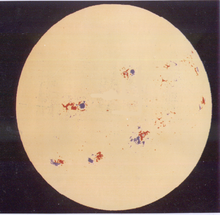
Solar cycle 20

Solar cycle 20 was the twentieth solar cycle since 1755, when extensive recording of solar sunspot activity began. The solar cycle lasted 11.4 years, beginning in October 1964 and ending in March 1976. The maximum smoothed sunspot number (SIDC formula) observed during the solar cycle was 156.6 (November 1968), and the starting minimum was 14.3. During the minimum transit from solar cycle 20 to 21, there were a total of 272 days with no sunspots. Solar cycle 20 was the twentieth solar cycle since 1755, when extensive recording of solar sunspot activity began. The solar cycle lasted 11.4 years, beginning in October 1964 and ending in March 1976. The maximum smoothed sunspot number (SIDC formula) observed during the solar cycle was 156.6 (November 1968), and the starting minimum was 14.3. During the minimum transit from solar cycle 20 to 21, there were a total of 272 days with no sunspots. Comparison with other cycles shows that geomagnetic activity during the declining phase of cycle 20 (1973–1975) was unusually high. Data from solar cycle 20 was used to build the K-1974 solar proton fluence model, used for planning space missions during solar cycle 21. An extremely active sunspot region, McMath 11976, produced a historic series of flares and CMEs in July, one CME transited to Earth in a record lowest 14.6 hours and produced a strong geomagnetic storm that caused widespread electrical and communications grid disturbances, and notably, the accidental detonation of numerous U.S. Navy magnetic sea mines in North Vietnam.
